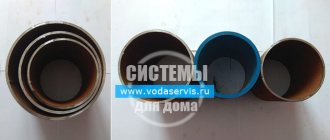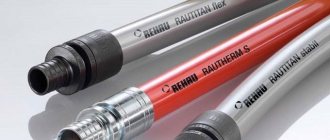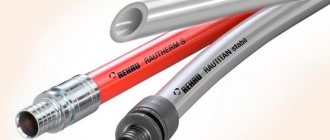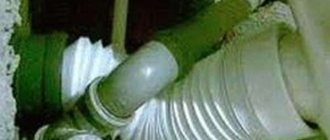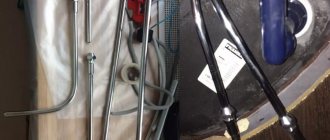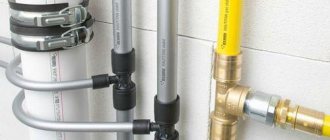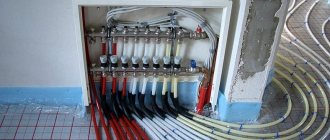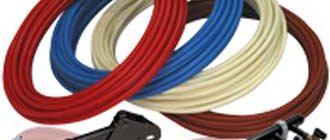Pipe overview
When laying the heated floor contour, the following is used:
- metal-plastic pipes;
- polyethylene pipes with increased heat resistance PE-RT type I and II;
- pipes made of cross-linked polyethylene PE-X.
Moreover, PE-RT type II and PE-X pipes may or may not have an EVOH oxygen protective layer.
Let's take a look at the thermal conductivity of pipes for water heated floors. So:
- Metal-plastic - 0.43;
- PE-RT type II - 0.38;
- PE-X - 0.35.
Directly in the case of warm water floors, these are very good indicators, indicating full heat transfer into the screed. Note that polypropylene has a thermal conductivity of 0.24. There is a clear difference in heat transfer rates, but it is insignificant. Despite this, a metal-plastic pipe heats the floor a little faster than polyethylene pipes. But this indicator no longer affects a further decrease in temperature.
Since the heat transfer of metal-plastic is slightly increased, this can be explained by the presence of an aluminum layer with high thermal conductivity. That is why the pipe is called “metal-plastic”. And the polymer layers in this type of pipe are PE-RT or PE-X. This is determined by the manufacturer's brand.
Which is better – cross-linked polyethylene or metal-plastic for heated floors?
Both polymers are actively used by craftsmen when installing this type of heating. I will describe their pros and cons in more detail in order to fully appreciate the capabilities of each.
Characteristics and properties
Cross-linked polyethylene (PEX) appeared not so long ago, but has already proven itself to be the best among polymer analogues.
It is obtained by processing (cross-linking) polyethylene. Volumetric transverse intramolecular bonds are formed in the polymer structure. Their quantity in relation to the total mass of raw materials determines the degree of crosslinking. The normalized value is from 65 to 80%.
There are three types of cross-linked polyethylene, each of which has a certain level of cross-linking and corresponding markings:
- PEX-A – degree of cross-linking up to 85%.
- PEX-B – no less than 65%.
- PEX-C – 60%.
There is also a recently introduced polyethylene with higher heat resistance - PE-RT. The crosslinking process made it possible to make polyethylene products more heat-resistant (withstand 95°C), improve their elasticity and strength.
However, the stitching method does not matter much. It is much more important to make sure that what you are looking at is truly cross-linked polyethylene. The letter X just indicates this. There are cases when unscrupulous manufacturers label PEX, but in reality it turns out to be ordinary polyethylene, which cannot be used in heated floors.
Polyethylene pipes are manufactured in different densities from PE32 to PE100. In underfloor heating circuits, craftsmen consider it better to use PEX-B polyethylene bends with a density of 100, which have an oxygen-protective layer, suitable performance characteristics and a lower price.
Cross-linked PEX polyethylene, intended for installation in hidden heating pipelines, is painted red and sold in coils.
The metal-plastic pipe has a five-layer structure. It consists of a thin aluminum layer on which the inner and surface layers of cross-linked polyethylene are fixed with glue. The metal cylinder gives the metal-plastic sufficient strength and 100% protection from oxygen. The marking looks like PEX-AL-PEX.
Metal-plastic can withstand heating up to 95° at a pressure of up to 10 bar, and in emergency situations – up to 130°.
In terms of indicators such as thermal stability, thermal conductivity, and thermal expansion, metal-plastic pipes are leaders among polymer types.
A little about layers
Let's look at the metal-plastic layer by layer. The layers are substituted with the following composition:
- polyethylene;
- glue;
- aluminum;
- glue;
- polyethylene, i.e. a total of five layers.
Polyethylene pipes, depending on their type and manufacturer, may contain exclusively polyethylene: cross-linked or heat-resistant. And there are three layers: polyethylene, glue, anti-diffusion layer EVOH. The next type of pipe, consisting of five layers, is quite rare. It includes: polyethylene, glue, EVOH, glue, polyethylene.
It can be concluded that unreinforced polyethylene pipes have various options. When metal-plastic does not have such variability. And this suggests that the process of its manufacture is more complex in terms of execution technology. Therefore, the pipe has an increased cost. The heterogeneity of metal-plastic lies in the fact that with different temperature expansion of the layers during the operational process, their delamination occurs. Therefore, the service life of these pipes is very difficult to calculate. This is influenced by various factors. It may be the quality of glue, polymers, foil and its welding.
In this case, with polyethylene pipes with their uniform wall, nothing raises questions, because each of them has a certain service life. But it is also true that a metal-plastic pipe can withstand greater pressure when breaking than its polyethylene counterparts without reinforcement.
The pressure and temperature in a warm field are incomparably small compared to the safety factor of those and other types of pipes. Based on this, it is not the strength at all, but the uniformity and rate of wear of the pipes that is of incomparably greater importance.
If we make heated floors, we mean that they will serve us for years and even decades. It's worth thinking about what's more important. Because the maximum temperature in underfloor heating pipes reaches 55 degrees, in extreme cases - 60 degrees. In this case, the pressure is 3 bars.
You need to know that heated floors have a fourth class of operation. This number, or the number five, should be on the pipe marking. At the same time, class 4 pipes have the most optimal characteristics for use in heated floors.
Criterias of choice
When choosing a material for the construction of communications, the decisive argument should not be considerations of economic benefit or installation complexity, but the compliance of the technical characteristics of the pipes with the expected operating conditions.
In the case of installing heated floors, the following requirements apply to pipe materials:
- Durability . According to official requirements for pipes for heated floors, it is prohibited to use ferrous rolled metal and seamed pipes. Steel products without special anti-corrosion protection in a walled-up state will not last long. The connecting seam is a “weak” point when hydraulic pressure increases in the heating system. The use of such materials will quickly lead to an emergency situation, the elimination of which will require opening the concrete screed.
- Chemical inertness . For long-term operation without reducing the internal clearance, pipes with a perfectly smooth inner wall are required. The coolant contains salts of alkaline earth metals, which, during long-term operation, are deposited on the inner walls of most pipe materials.
- Resistance to mechanical loads without deformation . The minimum concrete screed exerts a pressure on the pipes equal to 10 kg of weight per square meter. cm. Soft plastic pipes will be deformed under this load, and too hard plastic may burst.
- Resistance to high temperature and pressure of the carrier in the heating system . The minimum required stability parameters are 95 degrees and 10 atm. respectively.
- High level of heat transfer . For efficient heating, it is important that communications are not a barrier between the coolant and the air.
- No connections under the screed . Pipe materials are required that can be laid in one piece up to 120 m long.
- Flexibility and fracture resistance . When laying heated floors, it is important that the pipes are flexible enough to bend without damaging the walls and deforming the internal section with a minimum radius. Large distances between pipes cause cold segments.
We recommend that you familiarize yourself with: Corrugated flexible hose for pipelines
The choice of this or that material is also influenced by the type of heating in the house. If this is a central system, then the heated floor will be subject to more severe loads than with an individual circuit.
Note! Those looking for the ideal option for underfloor heating should consider using copper materials. Copper has a much greater safety margin than is necessary in this case. There are two disadvantages - complicated installation and high price of copper pipes.
Metal-plastic and cross-linked polyethylene are very close in their technical and price characteristics. Comparing their positive and negative sides will allow you to make the right choice in each specific case.
Pipe connections
Before installing the fitting on metal-plastic, it will need to be calibrated and the chamfer removed. And polyethylene pipes such as PE-RT and PE-X do not require additional preparation for installing fittings. In this case, the pipe must have even cuts.
Pipes are distinguished during installation and contour laying. A loop is made from a polyethylene pipe and laid manually. The minimum loop diameter consists of five outer diameters of the pipe. With a pipe diameter of 16 mm, the minimum loop diameter should be 8 cm. For the circuit, these are the most suitable indicators.
Polyethylene pipes
Cross-linked polyethylene is a modern high-tech chemical product. Cross-linking of the polymer occurs at the molecular level. Ordinary polyethylene is a long linear chain of molecules. Modern technologies allow chemists to link these molecules together with strong additional chemical bonds. Just as threads form strong fabric, linear molecules form a three-dimensional web of cross-linked polyethylene.
There are several technologies for the production of cross-linked polyethylene. They differ in their cost, percentage of connected linear molecules at the output, and labeling. To install a heated floor, pipes with a crosslinking percentage of at least 65% are required.
PEX-a pipes have up to 85% cross-linked molecules. Their production process is quite expensive, but guarantees high-quality material. The technology for producing PEX-b pipes is cheaper, but produces only 65% of the connected molecules.
Note! Pipes marked PEX-c for floor insulation are not reliable enough.
The best properties of polyethylene pipes:
- High elasticity – allows pipes to be laid as close to each other as possible without damage.
- Low expansion coefficient. Cross-linked polyethylene does not “walk” under concrete when the temperature changes. Resistance to mechanical influences from outside and outside. The material does not deform under the concrete screed and does not burst when frozen with water.
- The ability to return to its original form. This guarantees tightness when using fittings and no deformation at the bend.
- Inert to chemical and biological influences. Pipes do not rot or be destroyed by aggressive environments.
- Compliance of the technical characteristics of the material with operating conditions. Cross-linked polyethylene can withstand water heating up to 90 degrees (recommended temperature 80) and pressure up to 8 atm.
We recommend that you read: What is a vent pipe and is it needed in a private home?
Cross-linked polyethylene has few disadvantages and they are related to installation. The high elasticity of the material in bending requires pipelayers to rigidly fix the pipes during installation. The second point is the need to preserve the external protective coating. This makes the work somewhat more complicated compared to metal-plastic.
How to bend pipes?
It is easy to bend a metal-plastic pipe. She holds the corner. But if you bend it incorrectly, it can break. In order to bend a metal-plastic pipe safely with any diameter, it is necessary to use special tools. This device is called a “conductor”. It can be both external and internal. But, it is simply necessary.
In order to bend a polyethylene pipe, it is necessary to heat it with a special construction hair dryer to a temperature of 130 degrees. Under such conditions it will not break. However, if such a pipe breaks when you try to bend it, you can fix it with the same hair dryer. Moreover, this will not affect the quality of work in any way. If a metal-plastic pipe breaks, it will need to be replaced.
Types of pipes
The water circuit is the main part of the water floor design. The choice of material from which the pipes are made will determine how long the floor will last.
Let's consider the most popular options, paying special attention to the metal-plastic option
Steel pipes
It would seem that this is a fairly popular option. Reliable, strong, endowed with a long service life. However, this type is categorically incompatible with a heated floor system.
Steel pipes for heated floors
Steel is quite heavy, and together with other elements, including coolant and concrete screed, this will create enormous pressure on the floors.
The use of steel pipes is permitted only for connecting the boiler room and the distribution manifold cabinet, but in no case for laying the circuit.
Copper pipes
Still not ideal, despite the advantages. Copper heats up well and gives off heat, does not corrode, copper products are ductile and very durable, and are also not afraid of temperature changes. But to install this copper circuit you need special equipment and skills, and the price of the material is very high.
Stainless steel corrugated pipes
They have a number of qualities acceptable for installation. The products are flexible, durable, do not corrode, are resistant to aggressive environments, and such pipes are much easier to connect than other types. The only thing they can't boast about is their very high prices.
Polymer
Not a bad option for installation. The products last from 20 to 35 years, are resistant to adverse environments, are made of environmentally friendly materials, do not allow noise to pass through, and also have an increased ability to pass water.
Inferiority of products due to the use of a large number of elements in the composition. It includes: polyethylene, PVC, chlorinated PVC, reinforced aluminum PVC, polybutene.
The components create a maximum temperature of 95°C, which is not good for underfloor heating. To regulate the heating, you will have to install automatic control equipment.
Polyethylene cross-linked
Polyethylene materials are most suitable for underfloor heating systems. Durable, reliable, very flexible. Resistant to ultraviolet radiation, do not deform due to exposure to aggressive substances. Equipped with a sound-absorbing surface.
Assembling a polyethylene pipeline will not be a problem. The connection can be permanent or detachable. Detachable ones are fastened with brass fittings, one-piece ones are connected with fittings and special couplings.
Polypropylene
They are considered a good option along with polyethylene ones. They have a set of qualities approximately similar to the previous types, and are additionally endowed with heat resistance.
However, the material is not resistant to ultraviolet radiation and is short-lived at the junction with metal pipes.
In addition, they are only allowed to be connected at positive temperatures, and they are connected by welding. This is also considered a disadvantage, since most people simply cannot weld the circuit correctly.
PVC pipes
They have a low maximum heating limit of 75°C. This mark is not suitable for heated floors, so the material is reinforced with chlorination, which is unacceptable, since when heated, fumes that are caustic for the human body will be released. In addition to chlorination, reinforcement is used to also increase heat resistance. There are 2 types of reinforced PVC pipes:
- the reinforced aluminum body is located in the middle of the structure;
- reinforcement frames the second layer after the outer one;
Metal-plastic pipes
One of the leading options for laying the contour of a water floor along with polyethylene and polypropylene. Excellent heat transfer with high-quality room heating is supported by a service life of up to 45-50 years. In addition to this product are equipped with:
- simple installation;
- no corrosion;
- temperature resistance;
- small price;
- smooth inner surface;
- increased strength;
Minuses:
- during installation you need to use a special type of fittings;
- connections may be destroyed due to a layer of scale;
- possible delamination of the pipe circuit.
Metal-plastic pipes for heated floors
Oxygen permeability of pipes
Many customers of heated floors think about this. Metal-plastic, due to its aluminum layer, is indifferent to the penetration of oxygen into the system, and this is an irrefutable fact. Polyethylene pipes cannot allow oxygen to pass through when coated with a special EVOH barrier coating, i.e. these are three or five-layer pipes.
Why then do we need pipes for heated floors without a protective layer on them? Why are these comparisons necessary? The point is that only in a pipe filled with water does the oxygen permeability effect operate. And when antifreeze and similar liquids are used, they do not absorb oxygen. Therefore, when we use antifreeze when filling pipes with water, we can forget about oxygen permeability. So under this condition, you can use single-layer polyethylene pipes for heated floors.
Linear expansion for metal-plastic pipes is 6-7 times less compared to polyethylene analogues. In any case, a similar function for heated floors is the concrete screed. When the screed hardens, the pipe does not move.
Evaluation criteria for pipe materials
I will list the main points of operating a water pipeline for floor heating. Taken into account:
- Heating temperature. It fluctuates in the range of 30...55 °C.
- Constant pressure in the circuit. It will be 1.5-2 bar; when testing the system, a pressure of 6 bar is used.
- The pipeline is most often located in a screed, where it is subjected to pressure from the pressure of water and concrete.
Thus, the most important parameters of pipes for heated floors:
- Operating temperature 30...55 °C.
- Pressure up to 6 bar.
- Sufficient thermal conductivity.
Protection against oxygen penetration into the channel, thermal expansion indicators, corrosion resistance, and ease of installation are also important.
Installation of polypropylene pipes
The main advantage of polypropylene products is monolithic joining. The layers of the pipe are soldered together at high temperature using a special soldering iron. Therefore, individual elements become a single whole. Leakage is impossible in polypropylene pipes; they are often mounted in walls. But they are not suitable for use in rooms with temperatures of 0 o C and below.
Connecting polypropylene pipes is a much more complex process. It is performed using soldering. In this case, preliminary preparation is necessary (the pipe cut is cleaned, dirt is removed from the surface). The pipes themselves are not deformed, so water pipe bends are made by soldering additional elements. Although the materials themselves are cheaper, installation in the case of polypropylene pipes will be more expensive when compared with metal-plastic products.
As in the previous case, installation must fully comply with the technology. Only a person with experience in this matter can perform the task correctly. An amateur cannot cope with high-quality installation of polypropylene water supply.
Polypropylene pipes with reinforcement are intended for heating and hot water supply systems, because a simple analogue is deformed when exposed to high temperatures. Fastening of products is carried out using the sliding method. The riser is secured with hinges during installation.
Requirements for underfloor heating pipes
Theoretically, any pipeline is suitable for transporting coolant that is not too hot. Even assembled from various scraps. But in cases where leaks threaten to seriously waste money, reliability becomes a determining requirement. This is an abstract concept, like durability, that includes a whole range of characteristics. Therefore, the simplest and most obvious recommendation is to use only specially designed pipes.
Temperature resistance
Temperature resistance, necessary even though floor coverings do not heat up above 35°C. For heating, in any case, materials are used that can withstand heating up to 90° and above. This is due not only to peak temperature values, but also to the continuity of exposure. The structure of materials not intended for this purpose crystallizes if they are permanently heated to just 30-40°C and is destroyed.
Mechanical strength
Pipes must have mechanical strength sufficient to contain internal pressure, the weight of the concrete screed, various deformations, and the erosive effects of water. As a rule, the pressure in heating systems of private houses does not exceed 2 atm, but the pipe must withstand at least 6 atm. This figure will include almost any load.
Chemical inertness
Chemical inertness, including resistance to oxygen, electrochemical corrosion, coolant components, as well as aggressive alkaline environment formed by cement.
Sufficient pipe length
The length of a separate section of pipe must be sufficient to lay a separate circuit. This is perhaps the main reason why rolled steel is practically not used here, even from stainless steel. Any joint is a “weak link” in terms of strength and chemical inertness. At the same time, it disrupts the smoothness of the inner surface of the pipeline, reducing its permeability and increasing hydraulic losses.
Therefore, pipe intended for heated floors is most often sold in long sections, rolled into coils.
Options for laying pipe contours
Quality of materials and components
The quality of materials and components, confirmed by certificates, the name of the manufacturer, and consumer reviews. Of course, no one is safe from fakes. But a well-known European brand will definitely be more reliable than a “left noname”. Although you can test the pipe yourself by subjecting it to some extreme loads.
Interchangeability, fittings compliance with accepted standards
An unknown small manufacturer will not be able to saturate the market with them. Buying a pipe on the cheap, even a good one, is only half the battle. Without high-quality fittings, which have nothing to replace, it is completely useless.
Another significant nuance is oxygen diffusion. SNiP 2.04.05-91 directly states that the heating system pipeline must contain an anti-diffusion layer (oxygen barrier) that prevents the penetration of air into the system. We are talking here about polymer pipes - plastic (metal-plastic), polypropylene, polyethylene.
However, opponents of this statement provide their own arguments. For example, that even in a closed system the appearance of oxygen is inevitable. Therefore, the more important task is to eliminate it effectively. A safe, reliable way is to install air vents and (or) deaerators. You can also add hygroscopic additives - toxic hydrazine or sodium sulfite, but their content must be controlled.
Important: thermal conductivity is also a controversial parameter. It becomes key only if rapid heating is required, there are significant heat losses or the heat removal area is insufficient.
What is better to choose
Reliability and efficiency of metal fittings are gradually fading into the background. Nowadays, the majority of all installation specialists choose metal-plastic and polypropylene products. Their composition guarantees a long service life and ease of installation.
True, it is not so easy to decide which is better, metal-plastic samples or polypropylene pipes. There are several key factors to consider when choosing a material:
- When installing a water supply or small wiring yourself, the best option is metal-plastic. Anyone can install a fitting and tube with a simple wrench.
- If we are talking about purchasing a ready-made system, buy polypropylene. The material is cheaper, and you don’t have to install it yourself. No risks, plus savings.
- Looking for durability? Then only polypropylene samples. If installed correctly and without damage, such products will last for many decades.
- Do you need to install plumbing or heating in the walls, floors and other parts of the house? The choice is obvious - polypropylene. It is better to take samples with reliable reinforcement and permanent connections.
- When equipping hot water distribution, buy metal-plastic pipes of the middle price segment. They can withstand temperatures of +110° without risk, while polypropylene products are designed for a maximum of +95°.
As a result of analyzing all the characteristics, pros and cons of the most popular materials, we can say with confidence that polypropylene is the best option for most tasks. However, metal-plastic pipes are not inferior in many ways. The only difference between them is the operating temperature.
Advantages and disadvantages
What are the advantages of both materials when used for underfloor heating contours?
Polyethylene
The service life at an average temperature of 75 °C is 50 years. Such indicators are quite suitable for use in heated floors, where the maximum temperature for heating is 55 ° C.
They have good thermal conductivity - 0.38 W/(m•C). They are superior to polypropylene products in terms of heat transfer.
They are endowed with the property of memory, that is, they are able to restore their original shape after bending.
The material is much more flexible than metal-plastic and bends easily.
Properties such as smoothness of the inner layer, resistance to all types of corrosion, long service life (at least 30 years during normal use) are characteristic of both materials.
The main disadvantage of PEX is its strong thermal expansion when heated. It is capable of elongating by 1 cm per meter when heated to 50 °C. However, proper floor screed completely eliminates this drawback.
Metal-plastic
Thermal conductivity is 0.45 W/(m•C).
The normalized heating of metal-plastic at a pressure of 10 bar is 95 °C.
Linear thermal elongation is the lowest among plastics.
The flow of oxygen through the walls of the outlet is zero.
Metal-plastic bends well. Pipes with a cross-section of up to 20 mm can be easily bent by hand.
Experts include the following disadvantages of metal-plastic:
- Large bending radius (80 mm), as a result of which, if there is an error in installation, creases appear that cannot be corrected. If the pipe is bent, it will break easily. You will have to install a coupling or change the entire circuit.
- Fitting connections in a heated floor under a screed may weaken over time due to systematic temperature fluctuations.
Cross-linked polyethylene versus polypropylene: the benefits of PE-Xa for installers and consumers
When a person thinks about what to use for installing branches of a heating or water supply system in a house, he wants to save money. What does the consumer do? He goes online. It pops up the phrase “buy pipes for hot water and cold water” in the browser search. And it gets polypropylene pipes in the top list. Why are they so popular? The inertia of thinking takes its toll. This material has been known for a long time. Relatively cheap. Most people think that soldering a system based on polypropylene pipes is as easy as shelling pears. But there is a more modern and technologically advanced solution on the market - cross-linked polyethylene pipes. To understand their advantages, let's look at them from the point of view of benefits for the installer and compare them with polypropylene.
Simple installation of polypropylene pipes is a myth
About 25 years have passed since polypropylene, known since the 60s of the last century, began to be actively used in the Russian Federation for the installation of heating and water supply systems. Over the years, the material has proven itself well. It has become an alternative to steel pipes. It's inexpensive. Widely represented on the construction market. Relatively durable. Polypropylene pipes are suitable for cold and hot water supply and can withstand pressure up to 2.5 MPa. For clarity, we present the following table, which shows the technical characteristics of PP pipes and their scope depending on the type.
Note: The PN marking is indicated on the PP pipe.
It is not surprising that many people prefer them. According to fans of polypropylene, one of the main advantages of the material is its ease of installation. Is this really true? Let's imagine a situation - an installer needs to install a heating and water supply system in the “box” of a house under construction. It's autumn outside and the temperature ranges from +5-7 to 0 degrees with night frosts. At first glance, it seems that the task is not difficult. You take a soldering iron for welding polypropylene with a set of nozzles, and then pipes, fittings, angles, water sockets, taps, tees, adapters, couplings and expansion joints are welded into a single system. Pay attention to the diagram below.
As you can see, welding polypropylene pipes consists of a number of sequential steps, each of which directly affects the tightness of the connection and the service life of the system as a whole.
Important! The optimal mode for welding polypropylene is about 260 degrees Celsius at an ambient temperature of +20 - +25˚С. Look at the table.
The heating time of polypropylene pipes is regulated. When the temperature drops to +5 - +10˚С, you will have to keep the workpieces on the soldering iron longer. How will an installer do this in real life, and not in greenhouse conditions, as they demonstrate in training videos, when it’s cold outside or below 0 degrees? That's right - by eye. Will this connection be of high quality? Add the complexity of soldering polypropylene in awkward places. In the basements. In poor lighting conditions. When laying a route through interfloor ceilings and walls. After all, the pipe and fitting need to be heated at the same time. Often one pair of hands is not enough. Helpers needed. Those. the negative impact of the so-called increases "human factor" .
When welding polypropylene pipes, the quality of the joint is negatively affected by both exceeding the heating time and shortening it. When overheated, the material collapses inside the pipe. Surges form. As a result, the throughput of the heating or water supply system decreases.
If the polypropylene is underheated, the connection may leak.
Conclusions : you need to be able to solder polypropylene and the ease of working with PP pipes is a myth .
Let us add that polypropylene pipes are supplied in whips/rods only 2 or 4 m long. This automatically increases the number of fittings and connections when laying routes. In addition, PP pipes are not recommended for hidden installation in walls or floor screeds.
Advantages of cross-linked polyethylene pipes
It's 2021. Is there a better material than polypropylene? Progress did not stand still. A modern alternative to polypropylene is cross-linked polyethylene pipes from ELSEN. The assortment includes:
- Three-layer metal-polymer pipes Elspipe Triplex PE-Xc/AI/PE-RT, reinforced with an aluminum layer for strength and stability of the product. The outer layer of PE-RT provides additional protection for pipelines. The pipes are made in Germany.
- PE-Xa pipelines are universal silver-colored pipes for hot water supply and water supply, as well as red-colored pipes for low-temperature cooling and heating systems. The pipes are made in Sweden.
The PE-Xa marking indicates that the production used molecular cross-linking of polyethylene with organic peroxides or hydroperoxides. This method gives the material strength, stability and the best quality.
The technical characteristics of the pipes are listed in the table.
Note : the wall thickness of pipes for heated floors does not depend on the diameter of the pipeline and is equal to 2 mm.
All types of ELSEN cross-linked polyethylene pipes have an outer layer of EVOH, which prevents oxygen from entering the heating or water supply system.
All pipes are marked. Indicated:
- pipe diameter;
- operating pressure;
- maximum operating temperature.
PE-Xa ELSEN pipes can withstand temperatures up to +95 degrees Celsius. Pipes are supplied in coils. The length of the bays , depending on the type and diameter of the pipelines, varies from 50 to 240 m , which simplifies the work of the installer when laying branches and reduces the number of connections in the system .
Pipes made of cross-linked polyethylene do not rust. Eco-friendly. They have internal smooth walls, which prevents the formation of deposits.
Important! Pipes made from cross-linked polyethylene ELSEN PE-Xa have a “shape memory” or “molecular memory” effect. That is, the pipe, after deformations, creases, and kinks, returns to its original state.
PE-Xa cross-linked polyethylene pipes is the connection using axial fittings and a sliding sleeve . The company's product range includes tees, elbows, couplings and adapters.
The fittings are made of high-strength plastic - polyvinyl sulfone - a material that is not inferior in quality and reliability to metal products. The maximum operating temperature of axial fittings is up to 200˚С.
How to install cross-linked polyethylene pipes
Unlike polypropylene , and this is important, installation of PE-Xa pipes is carried out in a “cold” way without welding or soldering, using a simple set of hand tools from ELSEN.
In the photo above, from top to bottom:
- pressing pliers;
- expander;
- expansion tool attachments for pipes of various diameters;
- attachments - “vises” for pressing pliers.
Note : cut pipes with a pipe cutter. This guarantees a clean and even cut without burrs, which is important for obtaining a tight connection.
The installation process looks like this:
- Place a sliding sleeve on the cross-linked polyethylene pipe.
- Insert an expander into the end of the pipe and make at least three expansions by turning the pipe 120 degrees. The pipe expands uniformly.
- Insert a fitting into the widened end of the pipe, and move the sleeve as close to it as possible. The sliding sleeve has a special recess, which during installation must be pushed onto the side of the fitting.
- Take pressing pliers. Insert the fitting into them and press the connection.
- The sleeve is pushed onto the fitting and a tight and durable connection is obtained.
Elspipe Triplex PE-Xc metal-polymer pipes are installed in the same way - using axial fittings.
Summarizing
So, the main advantages of ELSEN pipes made of cross-linked polyethylene:
- the company's line of pipes covers the need for all types of heating and water supply systems;
- minimization of the so-called human factor, which minimizes the likelihood of errors by the installer;
- absence of “hot processes” - soldering and welding;
- the tool does not need to be connected to the electrical network;
- ease of work in cramped conditions, in hard-to-reach places, at low outside temperatures, high humidity, etc.
Some may object and say that cross-linked polyethylene pipes are more expensive than polypropylene. The final cost of a heating or water supply should be assessed by comparing all factors, and not just the price of pipelines . By using cross-linked polyethylene, you significantly benefit in installation speed with consistently high quality. The number of fittings and connections is reduced. Pipes can be embedded in a concrete screed. Lay it in grooves in the walls and thereby get an aesthetically pleasing system without open lines hanging on brackets.
Cross-linked polyethylene PE-Xa and reinforced pipes PE-Xc/AI/PE-RT last much longer than polypropylene - at least 50 years.
It is not necessary to buy a tool for installing fittings. You can rent it or get it at an attractive price if you purchase a large volume of cross-linked polyethylene pipes from the official ELSEN dealer in the Russian Federation - the HOGART company.
Conclusion
Summarizing all the arguments presented in the article about which pipes are better - polypropylene or metal-plastic, we can conclude that both materials have undoubted advantages. However, metal-polymer products are still inferior to propylene in terms of reliability and durability, and with almost equivalent costs (more fittings are required, but they are cheaper), the choice is often made in favor of plastic with permanent connections.
If you want to familiarize yourself with the features of the technologies and materials mentioned above in more detail, we recommend that you carefully study the video in this article.
Polyethylene and polypropylene. What is the difference
Polyethylene (PE) and polypropylene (PP) are common polymer materials in demand in industry. They are used for the manufacture of plastics, containers, pipes, packaging and thermal insulation fibers, etc.
There are many similar properties between polymers:
- Durability - retain their appearance when exposed to impacts.
- Versatility - they soften when heated, which makes it possible to use them in different areas.
- Ease of use - low weight.
- Practicality - not exposed to water, oxygen and salts.
- Electrical insulation - do not conduct electric current.
The difference between polypropylene and polyethylene
Polypropylene and polyethylene are widely used in industry and often seem the same to the consumer. But polymers have many differences.
What is the difference between polypropylene and polyethylene:
- Lightweight - PP weighs 0.04 g/cu. see less.
- Melting point - polypropylene melts at 180 degrees C, and polyethylene - at 140 degrees C.
- Care - PP products are practically not subject to contamination and are easy to clean.
- By synthesis methods - polyethylene is produced under any conditions, and polypropylene - at low pressure.
- Costs - manufacturing products from polypropylene is more expensive than producing polyethylene due to the high cost of raw materials.
What is the difference between polyethylene and polypropylene:
Elasticity - polyethylene is more flexible, and polypropylene is brittle.
- Frost resistance - PE does not lose its properties at temperatures down to -50 degrees C, and for PP it is destroyed at -5 degrees C.
- Lightweight - due to its low weight, polyethylene is suitable for the manufacture of films, packaging, pipes and insulating products.
- Lack of toxicity - when PE is heated, toxins disappear.
Film made of polyethylene and polypropylene: differences
Film made from PP and PE is used to protect fragile goods and has several differences:
- Cost-effective - with the same parameters as its analogue, polyethylene packaging is 50% cheaper.
- Presentable - glossy PP film looks much more attractive than a dull thing made of polyethylene.
- Practicality - polypropylene is less susceptible to creasing and does not lose its appearance due to loading and unloading operations.
- Resistance to temperatures - polypropylene becomes brittle from cold, and polyethylene tolerates freezing.
Which is stronger: polypropylene or polyethylene plastic
Plastic products are inexpensive and durable. Pipes, dishes and other products are obtained by synthesizing PE at low pressure. High-density polyethylene is less durable and is used in the manufacture of PET and tarpaulin.
Polypropylene is suitable for packaging, bologna clothing and fiber. PP is resistant to heat, solvents and bending. It is non-toxic, but is afraid of ultraviolet radiation and frost.
Polypropylene or polyethylene: which is better?
Both polymers are used in different industries. Depending on the synthesis method and application, polymer manufacturers achieve maximum benefits from polymers.
The conditions for the synthesis of raw materials affect the technical characteristics of polymers. For example, when creating pressure and choosing a catalyst, products with different chemical and physical characteristics are obtained.
Polypropylene is used to create building materials and various containers. High-density polyethylene is optimal for the production of pipes, and high-density polyethylene for the production of packaging.
Let's start with a metal-plastic pipe
This pipe consists of several layers, as is clearly demonstrated in the figure below.
The inner layer is often represented by cross-linked polyethylene, the smooth surface of which prevents carbonate deposits on its inner wall and protects the pipe from an aggressive environment.
The aluminum layer acts as reinforcement for the entire pipe and prevents the penetration of free oxygen into the medium it transports, which is an important characteristic when using the pipe in a heating system. After all, oxygen has a merciless and destructive effect on metal heating elements, reducing their service life significantly.
The top layer of a metal-plastic pipe consists of either polypropylene or the same material as the inner layers. This layer protects the aluminum layer from mechanical damage and chemical influences on it, and also gives the overall strength of the entire pipe.
The metal-plastic pipe can withstand high pressure while simultaneously being exposed to high temperatures.
If we list all the main advantages of a metal-plastic pipe, it will look like this:
- Protection against oxygen penetration when used in a heating system, in particular for heated floors
- Anti-corrosion properties of the pipe, that is, it does not rust and is not subject to electrochemical corrosion.
- Maximum operating pressure 10 atmospheres at maximum temperature 95 C
- Service life up to 50 years, subject to compliance with operating conditions
- Ease of installation. The pipe bends well by hand, which makes it possible to do without unnecessary connections.
- Low coefficient of thermal expansion
The disadvantages of metal-plastic pipes include the following:
- Different coefficients of linear expansion of pipe layers can cause their delamination. For the same reason, fitting joints may leak from time to time.
- If over-tightened, the threaded fitting may cut through the pipe.
- When water freezes in a pipe, it can burst.
- When bent, the pipe may break. It’s good that this will be a short section that you won’t mind replacing. And if you are laying a pipe in a heated floor, where it is necessary to make a lot of bends, and let’s say this happened to you, you will have to replace this circuit completely, because connecting the pipe in a heated floor screed is extremely undesirable.
Polypropylene
Compared to MP pipes, the walls of conventional PP pipes consist entirely of plastic. The exception is reinforced products, which are made using an aluminum layer.
PP pipe set
The foil used does not stick to the inner and outer layers of polypropylene. During the production of products, the layer is soldered into the polymer.
Main characteristics
Manufacturers produce four options for PP pipes:
- PN10 - products for cold water supply, capable of moving liquid with a pressure of maximum 1 MPa and a temperature of no more than +20 ° C. The products are also used when installing heated floors with coolant heated to +45 °C.
- PN16 - pipes for cold and hot water supply networks with a temperature and pressure, respectively, of no more than +60 ° C and 1.6 MPa.
- PN20 - pipelines for hot water supply that can withstand a maximum temperature of +80 °C and a pressure not exceeding 2 MPa.
- PN25 - PP products for hot water supply systems and centralized heating systems, in which the temperature can reach +95 ° C and the pressure is no more than 2.5 MPa.
Manufacturers produce PP pipe parts in white, gray, green and even black. The latter option is produced using special additives that increase the product’s resistance to ultraviolet radiation.
The reinforcing layer is created not only from aluminum foil, but also from fiberglass. In PN25 products, the reinforcing layer is located closer to the outer surface. In MP pipes, the aluminum layer is always located approximately in the middle of the wall thickness.
Connection Features
Polypropylene pipes are connected using soldering. The work uses special welding equipment. Even an inexperienced person can use such a device.
Connecting PP pipes by soldering
The likelihood of underheating of the polymer increases when installed in the cold. Soldering of PP pipes is prohibited at subzero temperatures. In cold weather, it is recommended to carry out the welding process indoors. The air temperature should be at least +10 °C.
PP connecting elements are sold at a lower price than fittings for metal-plastic. However, the labor intensity of their soldering is higher. PP pipes also have a higher coefficient of thermal expansion. When heated, PP products deform. Therefore, their sagging is often observed.
They even rest against building structures with capped ends or bends. This can lead to pipe destruction. To reduce this effect during installation, sliding fasteners are used and compensators are installed.
XLPE pipes
XLPE pipes - REX pipes . REX is an abbreviation for cross-linked polyethylene. This flexible, durable material is becoming an increasingly popular material. To give polyethylene strength and resistance to temperature influences, it is processed under high pressure. This leads to the formation of additional molecular bonds . This processing method is called *cross-linking*, which is why polyethylene is called cross-linked polyethylene.
Due to the three-dimensional molecular bonding in the structure of polyethylene, there are a number of advantages compared to traditional metal pipes. Three-dimensional molecular bonding increases the resistance of pipes to thermal deformation, abrasion, scratches, shrinkage, and cracking due to internal stress.
When choosing REX pipes, you should pay attention to the degree of crosslinking . The standard requires a certain degree of cross-linking, at least 65%, ranging from 65% to 80%. The stitching method affects the service life and technical characteristics, as well as the cost of the pipes.
There are three methods for producing cross-linked polyethylene, which affect the degree of cross-linking.
- Pyroxide (REX - a) - pyroxides are introduced into polyethylene. The degree of crosslinking is up to 85%.
- Silane (REX - b) - organosilanides are added to polyethylene. The degree of crosslinking is at least 65%.
- Radiation (REX - c) - degree of crosslinking 60%.
If the degree of crosslinking is 0%, then the pipes become too brittle and prone to cracking. Too little stitching can have equally serious consequences.
Pros of REX pipes
REX pipes have a number of advantages :
- low noise level of pipes due to its flexibility and ability to absorb pressure surges;
- ease;
- ease of installation;
- have *shape memory* , can easily restore their original shape;
- corrosion resistance;
- durability , operation is designed for a period of at least 50 years;
- resistance to freezing in cold weather;
- flexibility;
- minimal probability of *explosions* after defrosting the system;
- withstand high temperature and pressure changes.
